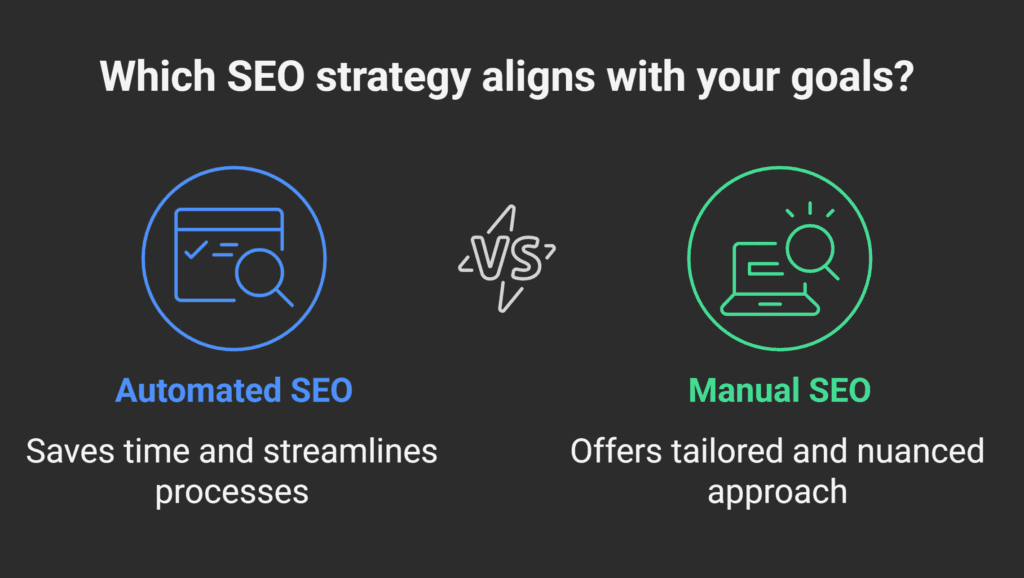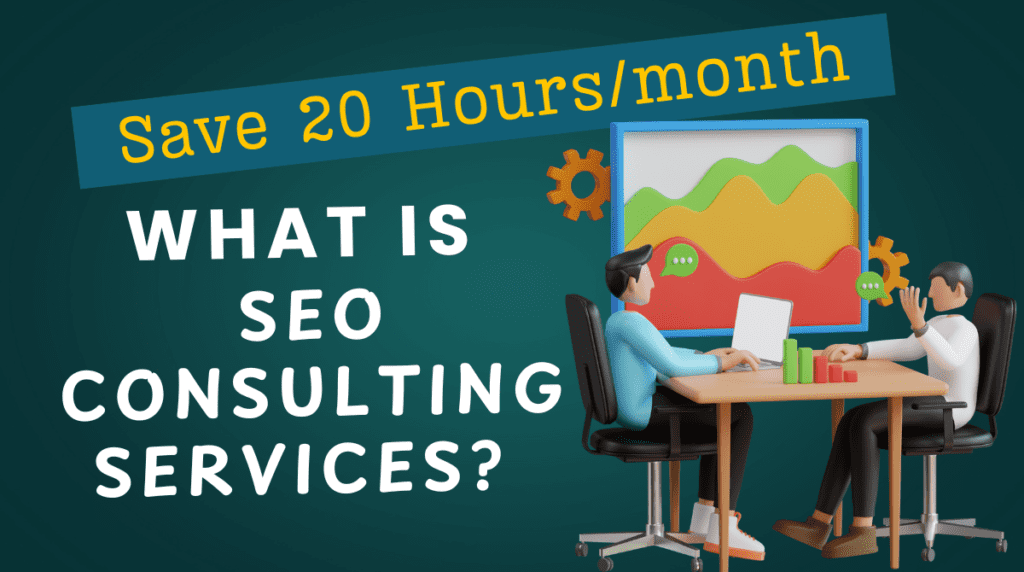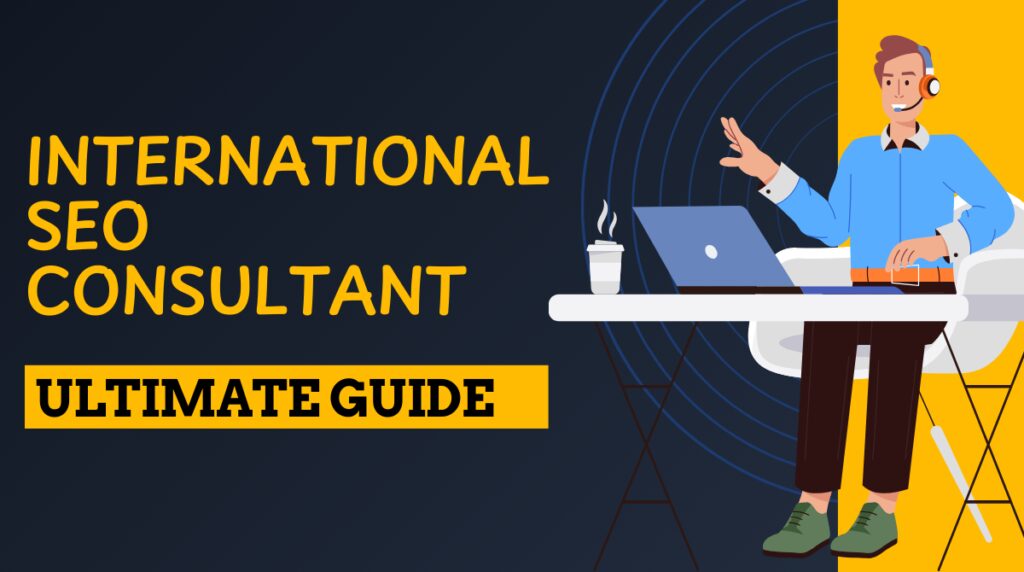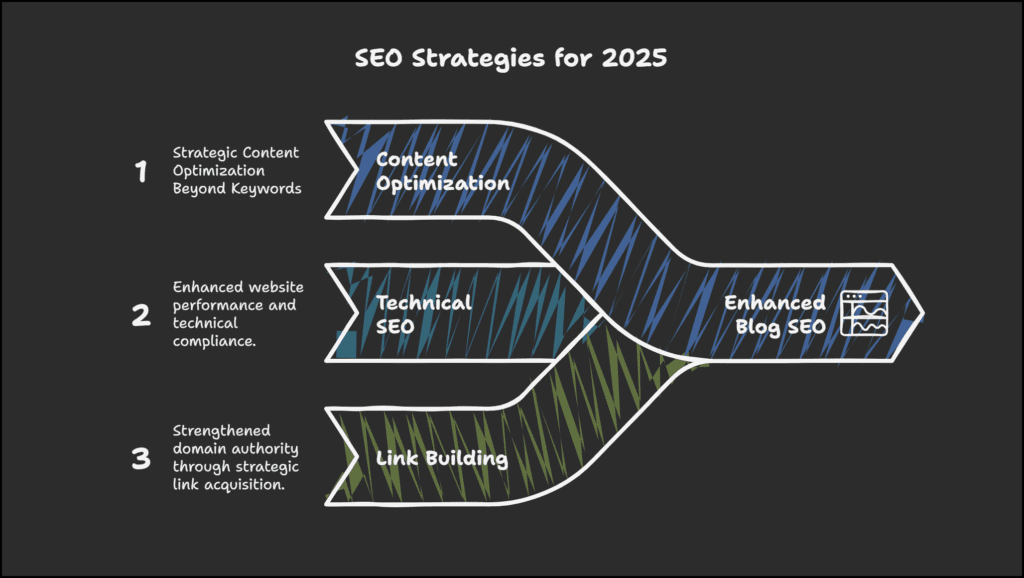Did you know that 68% of online experiences begin with a search engine?
SEO is like a roadmap that helps people find your website on Google.
In 2025, businesses will use two main strategies: automated SEO (using tools) and manual SEO (human effort). This guide explains both Automated seo vs manual SEO, their pros and cons, and how to mix them for success.
Let’s dive in!


Get your free SEO Score
What is SEO? A Quick Refresher
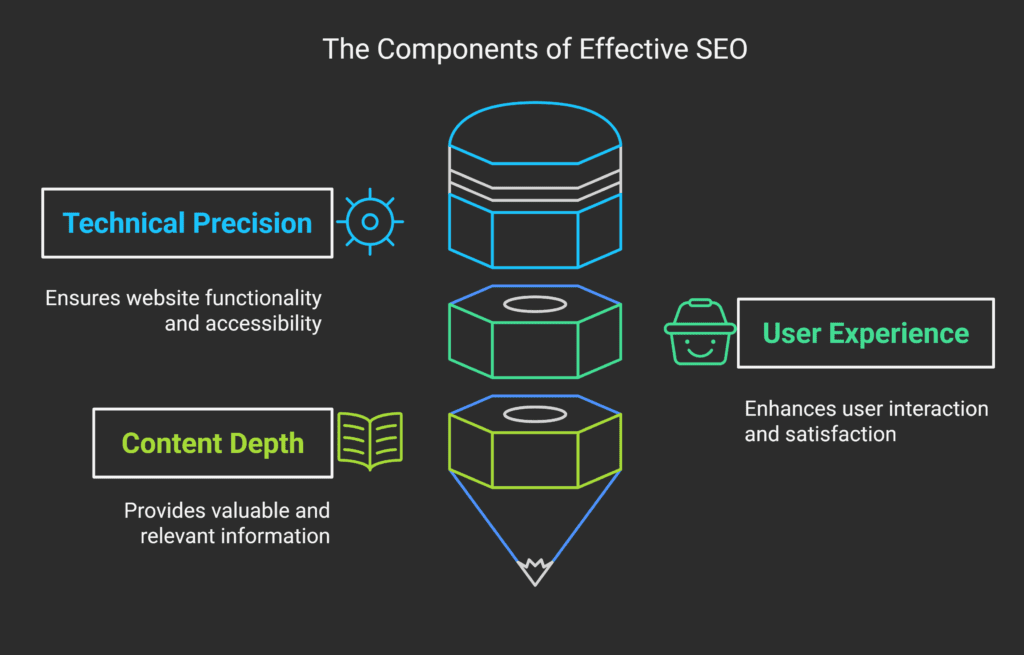
SEO stands for Search Engine Optimization.
SEO (Search Engine Optimization) is the process of optimizing your website to rank higher on Google, Bing, and other search engines. It’s not just about keywords modern SEO combines technical precision, user experience, and content depth to drive organic growth.
SEO helps your website rank higher on Google. Without proper SEO, your website might not get the rankings & visitors from the SERP.
It’s like making your website easy for Google to find and share. Good SEO means more people visit your site!
The Role of SEO in Modern Digital Marketing
SEO is important in digital marketing because it helps your website be seen by more people.
It makes sure your site is easy to find when people search for things related to your business.
With Google’s 2025 algorithm prioritizing E-E-A-T (Experience, Expertise, Authoritativeness, Trustworthiness), manual SEO for content depth and automated tools for technical audits are non-negotiable.
This can bring more visitors to your site.
Core Components: On-Page, Off-Page, and Technical SEO
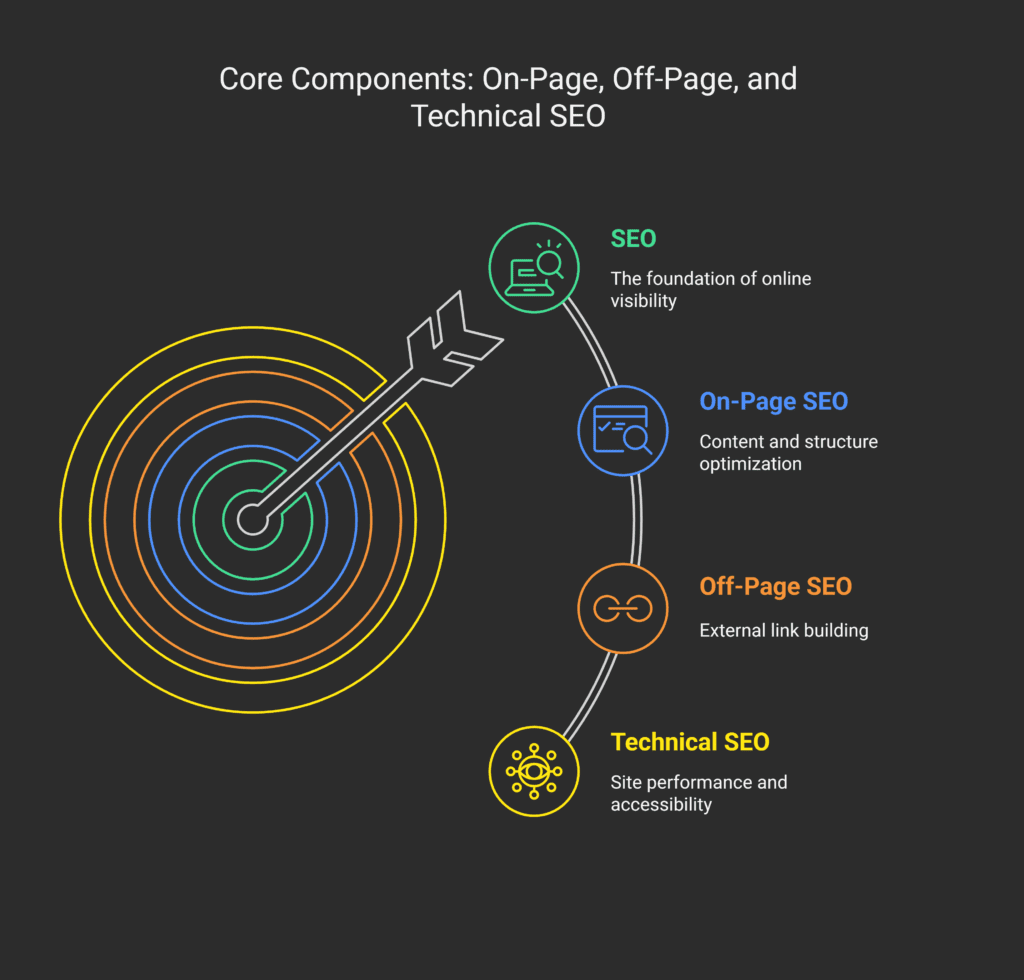
SEO has three main parts: On-Page, Off-Page, and Technical SEO.
1. On-Page SEO: Optimize title tags, headers, and content with tools like SurferSEO. Sites with optimized meta descriptions see 36% higher CTR (Backlinko).
2. Off-page SEO: Getting other websites to link to yours (like a friend recommending your pizza shop).
3. Technical SEO: Fixing website speed, mobile-friendliness, broken links, broken images, metadata that is too long or too short, etc. (like making sure your pizza shop has a working door).
Pages loading in 2 seconds have 9% higher conversions (Portent)
Automated SEO: Speed, Scalability, and Limitations
What is Automated SEO?
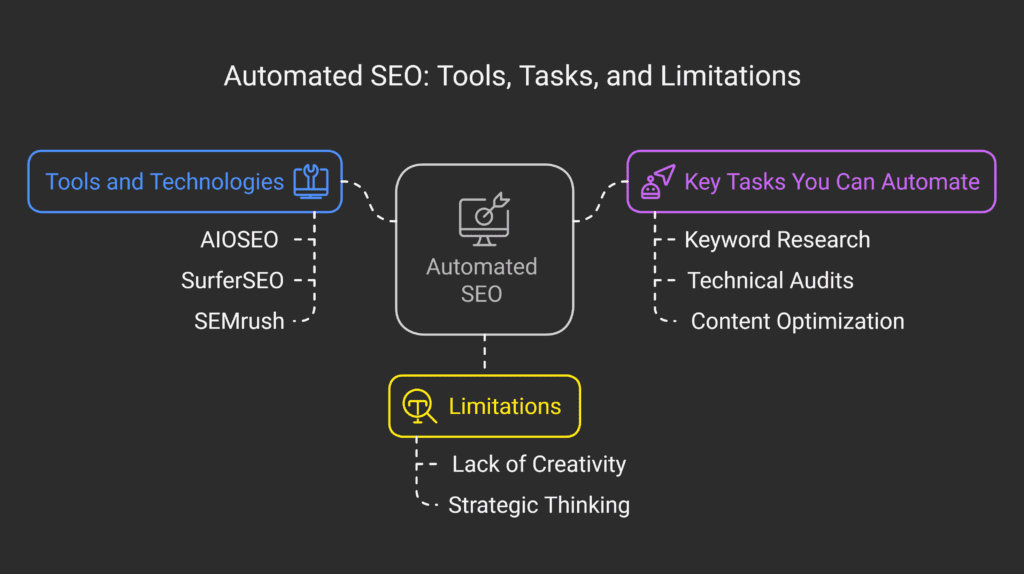
Automated SEO makes your website better for search engines faster and easier. These tools assist in keyword research, technical audits, and content optimization, reducing manual effort.
This approach speeds up processes but lacks human creativity and strategic thinking.
Tools and Technologies
Tools like AIOSEO, SurferSEO, and SEMrush help with automated SEO. They make it easier to optimize your website for search engines.
Real Life case Study Case Studies
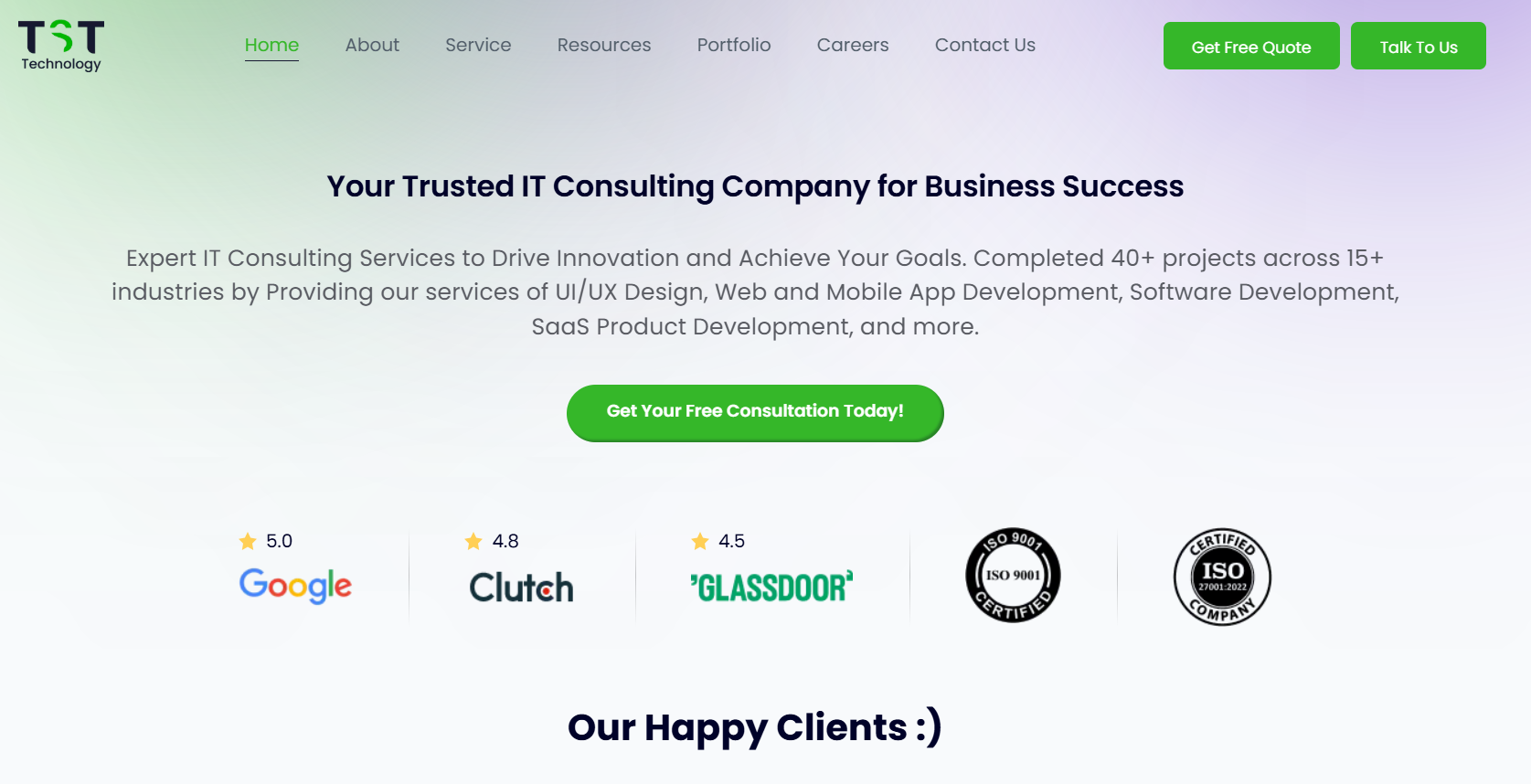
TST Technology
Increased domain authority from
0 to 38 DR of just 7 month 7-month-old website
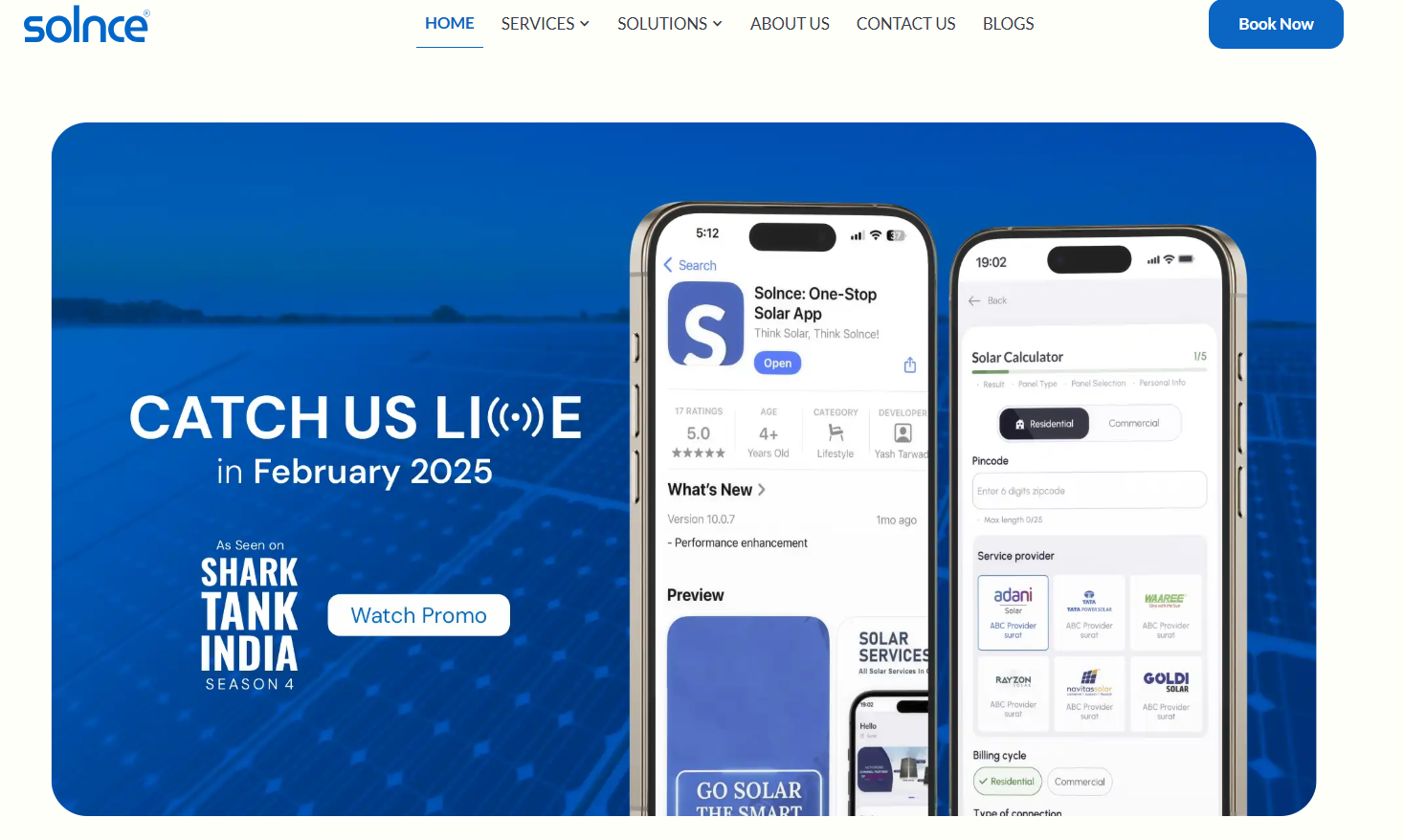
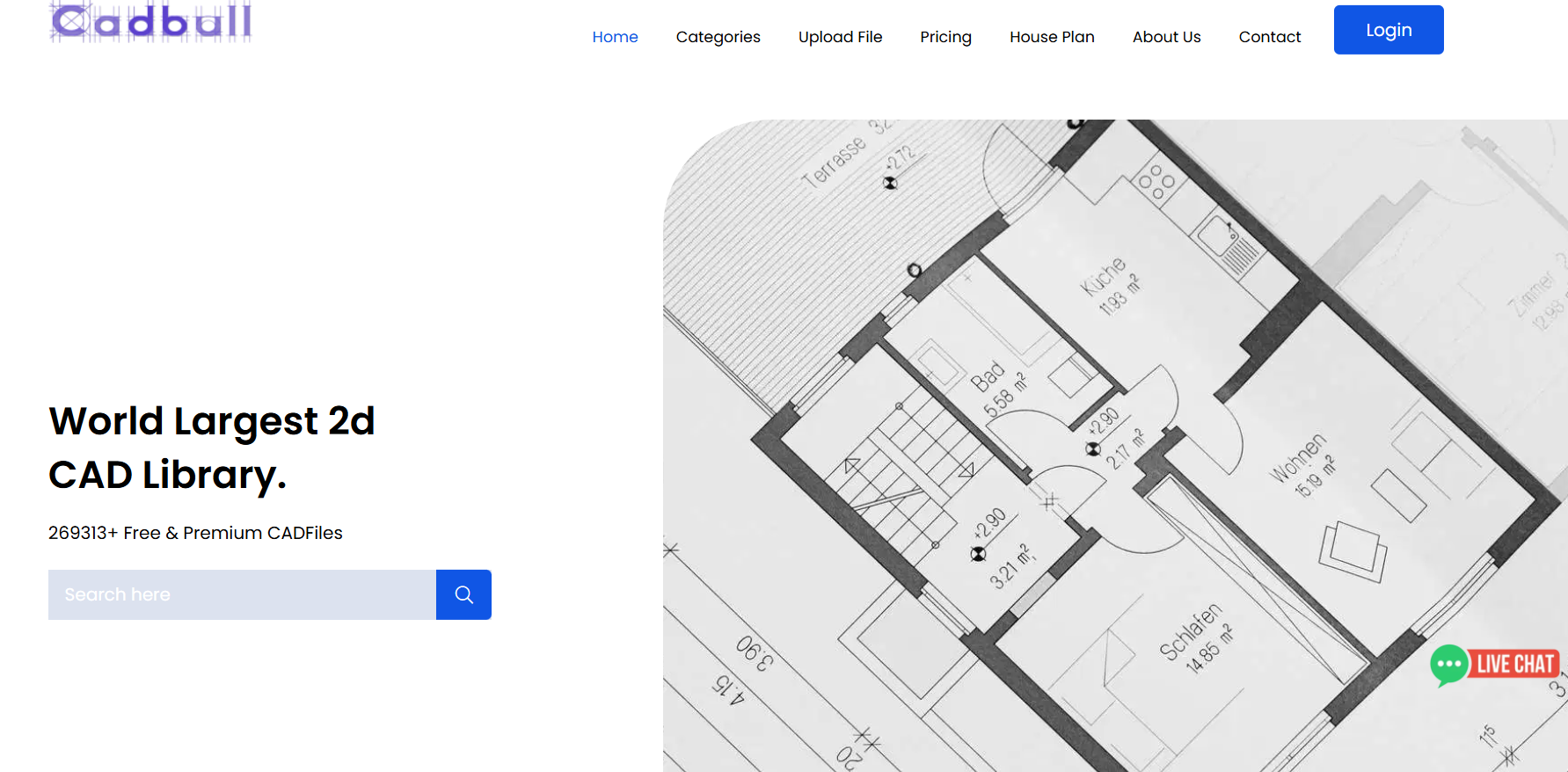
Key Tasks You Can Automate
Keyword Research
Tools like Ahrefs, SemRush and AnswerThePublic help find the best keywords for your website. We can easily find many keywords in just one simple click.
Technical Audits
Tools like Screaming Frog and SemRush Site Audit help you check your website problems like broken links, broken images, duplicate metadata, title page issues, site loading, etc.
Content Optimization
Tools like Surfer SEO & Grammerly make your content better for search engines. They suggest errors and phrases that we have to make properly optimizable.
Pros & Cons of Automated SEO
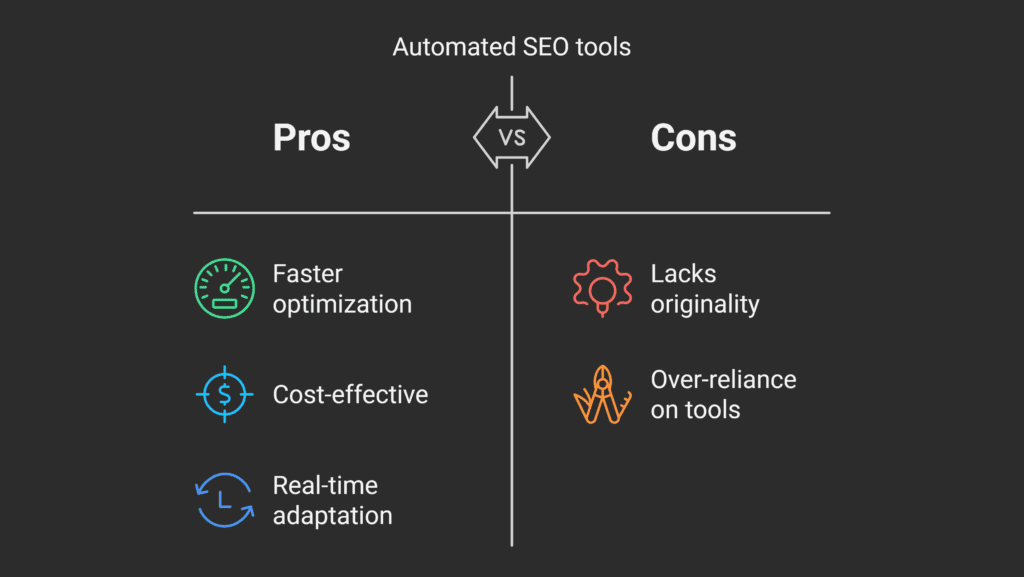
Pros of Automated SEO
Speed and Scalability
- Automated SEO makes content optimization faster. This means you can get more work done quickly.
Cost-Efficiency for Small Businesses
- Automated SEO tools can be cost-effective for small businesses. They help save money by doing tasks automatically.
Real-Time Algorithm Adaptation
- These tools help your website adapt to changes in search engine rules. This keeps your website visible to more people.
Cons of Automated SEO
Lack of Originality in Content Strategy
- Automated tools can make content less creative. They might not understand what people really want to read.
Over-Reliance on Tools
- Some automated audits miss important details. Companies using AI-driven SEO tools see a 35% increase in organic traffic within three months.
Read more about SEO automation tools: [5 Best SEO Tools You Should Be Using Right Now] (https://bhautikkapadiya.com/seo-tools ).
Manual SEO: Precision, Creativity, and Challenges
What is Manual SEO?
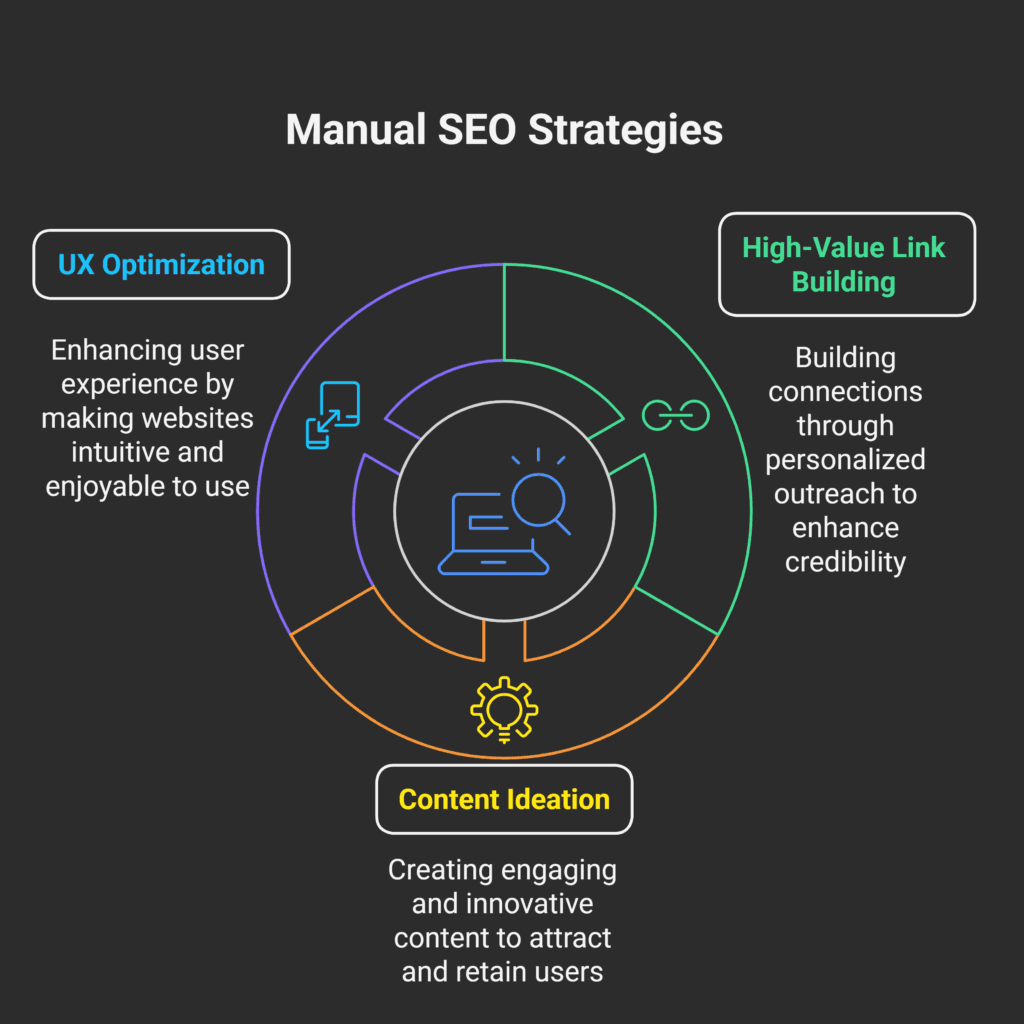
Manual SEO is when humans do the SEO work to make your website better for search engines.
It includes things like:
Human-Centric Strategies (e.g., personalized outreach, content depth)
- Personalized Outreach: This means reaching out to other websites to ask them to link back to you. It’s like asking friends to tell others about your cool project.
- Content Depth: This is about making sure your website has lots of useful information that people want to read. It’s like writing a really interesting book that everyone wants to read.
Key Tasks Requiring Manual Effort
High-Value Link Building
- This involves manually reaching out to other websites to get them to link to yours. It’s like getting a recommendation from a trusted friend.
—> For example, if you have a website about gardening, ask a popular gardening blog to link to your site.
Content Ideation and Storytelling
- Humans are good at coming up with new ideas for content and telling stories that people want to hear. This helps make your website more interesting and engaging.
—> For instance, you could write a story about how gardening changed someone’s life.
User Experience (UX) Optimization
- This is about making sure your website is easy and fun to use. Users can easily navigate and make sure everything works well.
—> It’s like making sure your playground is safe and fun for everyone.
Pros & Cons of Manual SEO
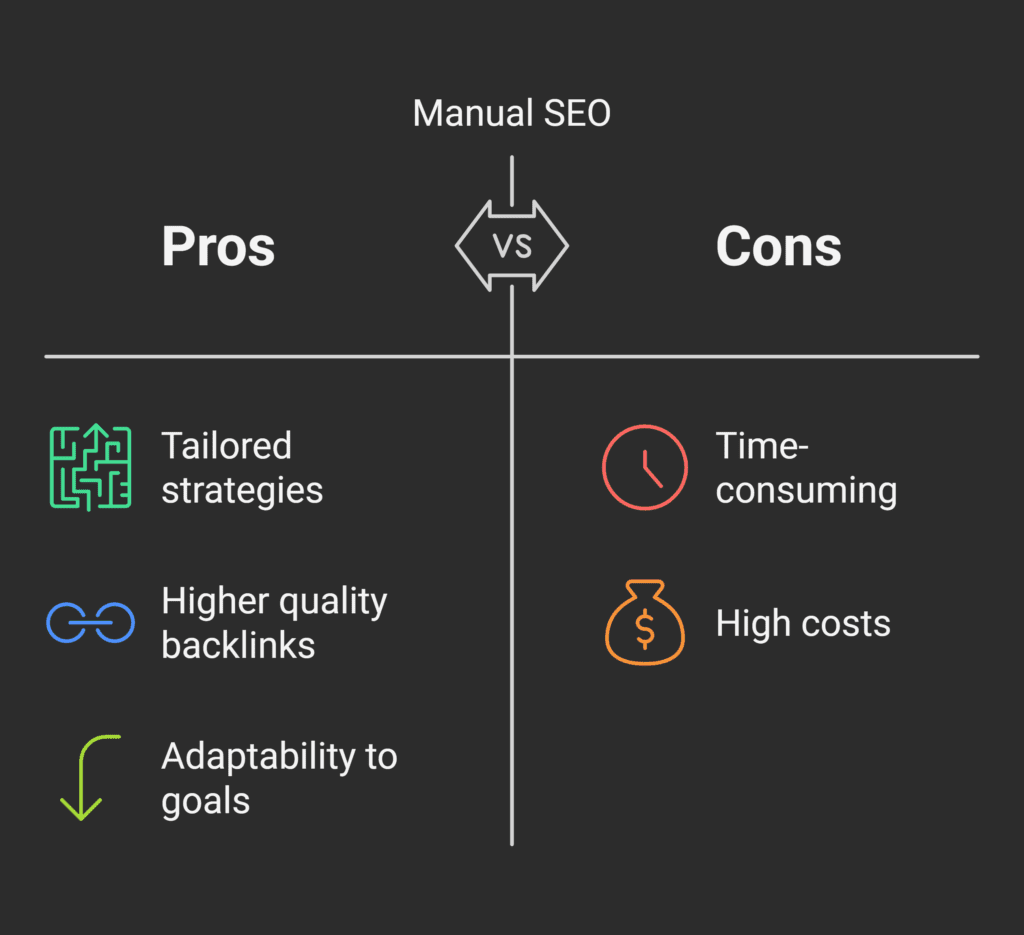
Pros of Manual SEO
Manual SEO has some big advantages:
Tailored Strategies for Niche Audiences
- You can make strategies that are just right for your specific audience. For example, if your website is about vegan cooking, you can tailor your content to appeal to vegans.
Higher Quality Backlinks
- Manual SEO can help you get better backlinks.
- Did you know that about 70% of manual links can drive referral traffic to your site? This means more people will visit your website than other sites.
Adaptability to Unique Business Goals
- You can adjust your SEO strategy to fit your business’s unique goals. This is important because every business is different.
For example, if your goal is to sell more gardening tools, you can focus on keywords related to gardening tools.
Cons of Manual SEO
There are also some challenges with manual SEO:
Time taken Processes
- Manual SEO takes a lot of time. It’s like doing homework every day. You have to spend hours doing tasks like reaching out to other websites or writing content.
Higher Costs for Enterprises
- If you have a big company, manual SEO can be expensive. You should hire a team of people to do all the work, which costs money.
How to Combine Automated and Manual SEO for Maximum Impact?
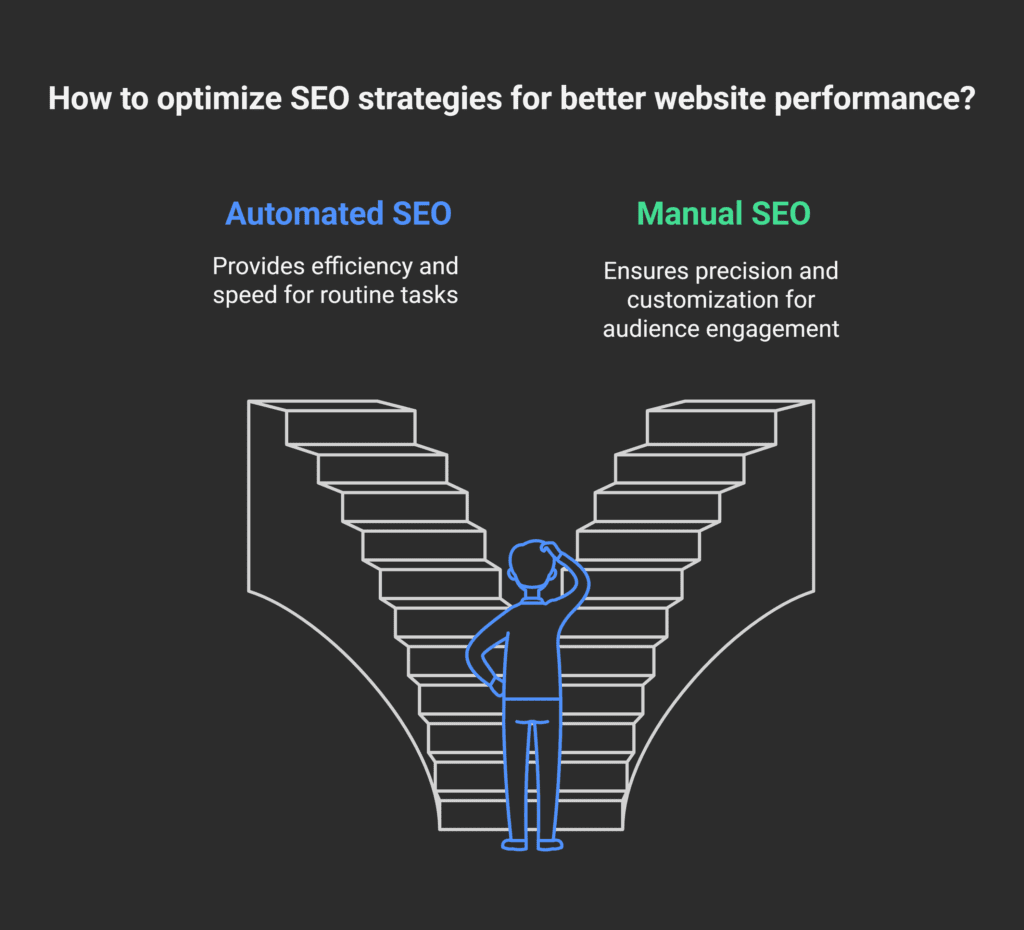
Combining automated and manual SEO strategies can help your website perform better. Combining automated and manual SEO is like having a super team for your website.
Automated SEO helps with fast and easy tasks, while manual SEO makes sure everything is perfect and just right for your audience.
Let’s explore how to do this step by step.
Step 1: Automate Repetitive Tasks
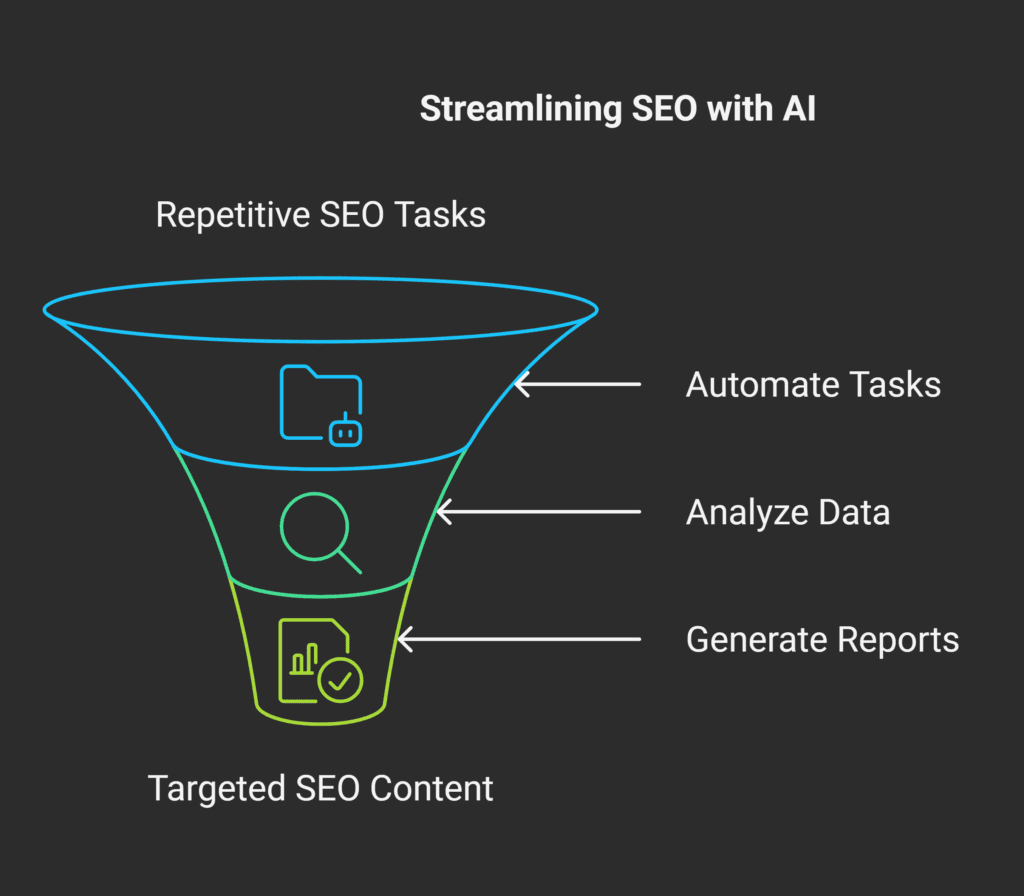
Automating routine tasks saves time and reduces errors. For example, using AI tools for keyword finding and keyword clustering can streamline your SEO efforts.
According to Pittsburgh Internet Consulting, automation tools can handle tasks like keyword research and site audits efficiently.
Imagine you have a big box full of toys, and you need to sort them by colour. That’s what AI does with keywords—it helps group them so you can use the right words in your content.
Tools like Ahrefs and SE Ranking are great for this job. They can analyze lots of data quickly and give you reports that help you understand what people are searching for.
Example: If you have a website about pets, AI can help you find all the keywords related to “dog care” and “cat care,” making it easier to write content that people will see when they search online.
Step 2: Manual Intervention for High-Impact Areas
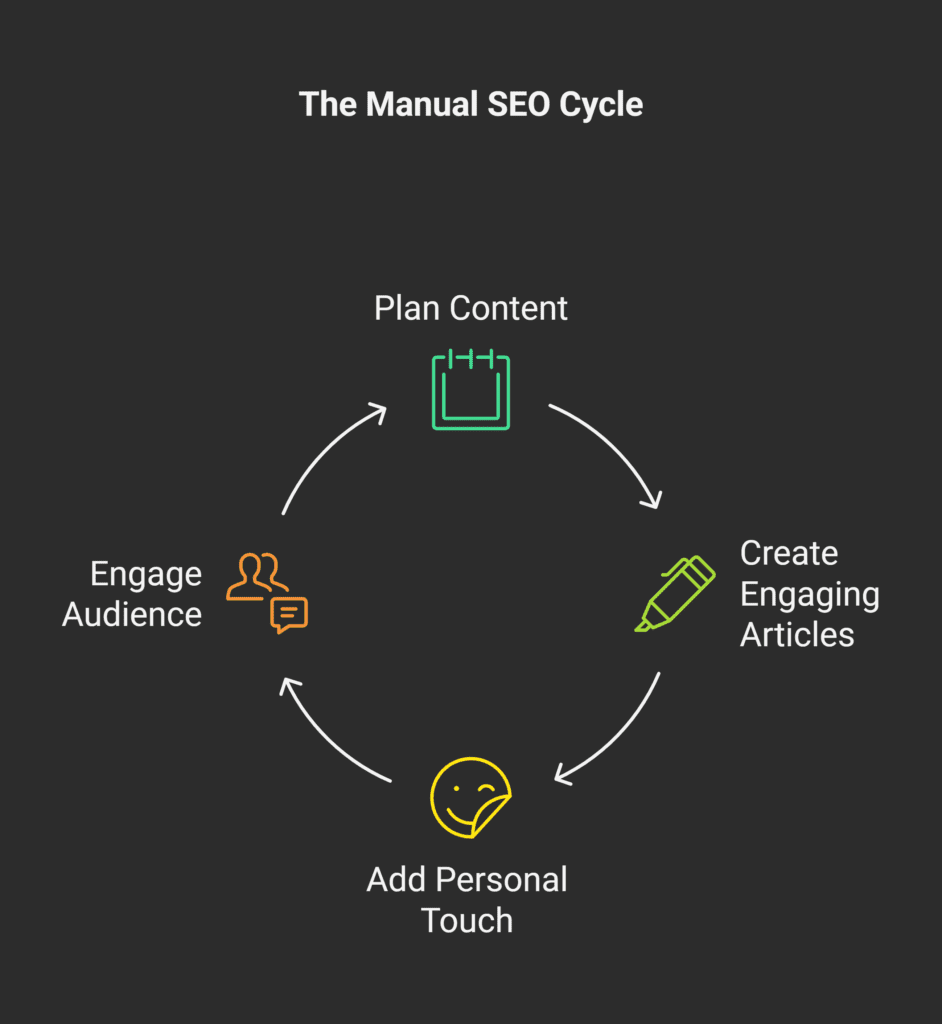
While automation is helpful, human touch is essential for creating quality content.
Crafting long-form articles and planning editorial calendars require creativity and an understanding of your audience. This manual approach ensures your content is engaging and valuable.
Manual SEO is like painting a picture. You need a human touch to make it beautiful and meaningful. Writing long articles and planning what content to publish and when is important for keeping your audience engaged.
It’s like planning a fun party – everything needs to be just right!
Example: If you’re writing about how to take care of a new puppy, a human can add stories and tips that make the content more interesting and helpful.
Step 3: Continuous Monitoring and Adjustment
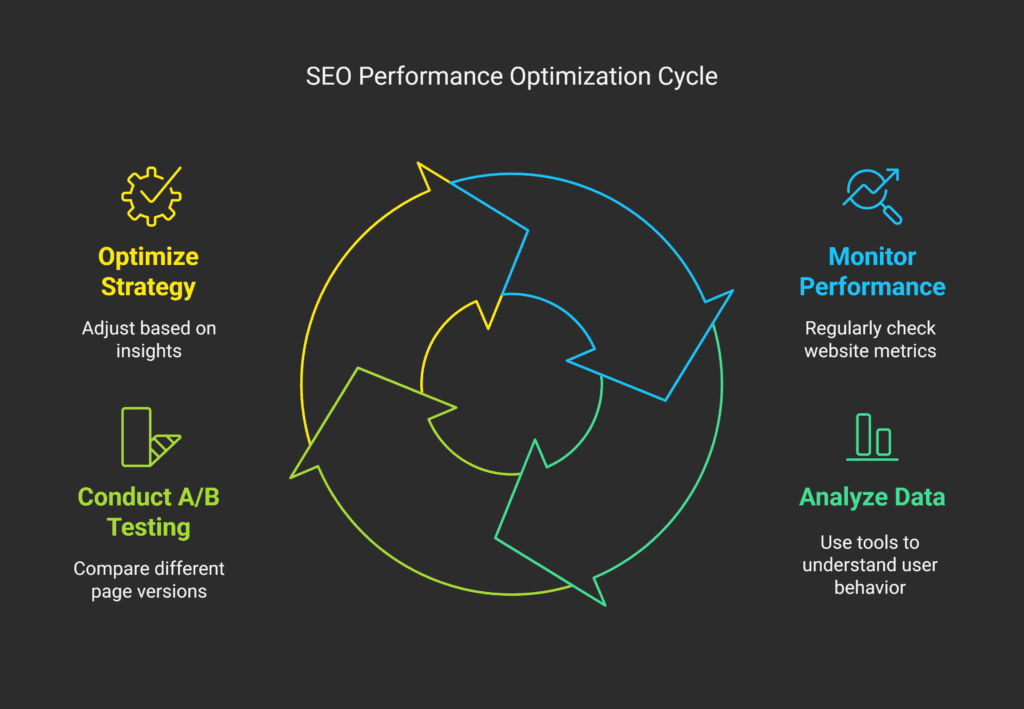
Regularly checking your website’s performance helps maintain and improve its ranking.
Combining tools like Google Analytics with manual A/B testing allows you to understand user behaviour and optimize accordingly. This hybrid approach ensures your SEO strategy adapts to changing trends.
After you’ve set up your SEO, you need to keep an eye on how it’s doing. Tools like Google Analytics help you see how many people are visiting your site and what they’re doing there.
Manual A/B testing is like trying two different flavours of ice cream to see which one people like better. You test two versions of a page to see which one works better.
Example: If you have two versions of a page about dog food, you can test which one gets more visitors and which one makes people stay longer on your site.
Conclusion
In 2025, automated SEO will save time, while manual SEO adds a personal touch.
Use tools for tasks like keyword research but rely on humans for storytelling and UX.
Mix both to stay ahead!
Frequently Asked Questions
Can Automated SEO Replace Human Experts?
No, automated SEO cannot fully replace human experts. While automation handles repetitive tasks efficiently, human expertise is crucial for strategic planning and creative content creation.
Which Strategy is Better for Local SEO?
A combined approach works best for local SEO. Automation can manage tasks like local listings, while manual efforts focus on community engagement and localized content.
How to Measure the Success of Hybrid SEO?
Success can be measured by tracking key performance indicators such as organic traffic, conversion rates, and search engine rankings. Utilizing analytics tools alongside manual assessments provides a comprehensive view of your SEO performance.

